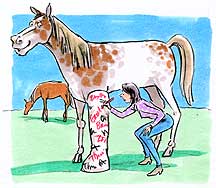 Fractures may happen to any animal, but they do seem to be especially prevalent
in rodeo and cow horses. The treatment used generally entails the kinds of
implements that are in use for humans, such as screws and also plates. Yet to
help the animals recover quicker there are now available extensive support
casts, quite often made from fiberglass, which take into account the need to put
weight on the affected limb right away. Another danger of the past was the risk
of infection. This was usually seen when the bone had punctured the skin, thus
leaving the limb susceptible to the introduction of bacteria. While such harmful
substances can still enter the horse, there are now useful antibiotics and means
by which to administer them which help the treatment of broken limbs succeed. Fractures may happen to any animal, but they do seem to be especially prevalent
in rodeo and cow horses. The treatment used generally entails the kinds of
implements that are in use for humans, such as screws and also plates. Yet to
help the animals recover quicker there are now available extensive support
casts, quite often made from fiberglass, which take into account the need to put
weight on the affected limb right away. Another danger of the past was the risk
of infection. This was usually seen when the bone had punctured the skin, thus
leaving the limb susceptible to the introduction of bacteria. While such harmful
substances can still enter the horse, there are now useful antibiotics and means
by which to administer them which help the treatment of broken limbs succeed.As a horse owner, there are a few things you will need to keep in mind if your
animal will need to be treated for a fractured limb. First and foremost,
carefully transport it to the veterinarian. You will need to ensure that the
affected limb is supported properly to not make the problem any worse. If the
bone has punctured the skin, you will need to cover it prior to transport. Once
it has successfully arrived at the vetís office, your animal will need to make
it through the surgery and subsequent recovery. Keep a close eye on the affected
to immediately report any signs of infection. Also keep a very watchful eye on
the leg opposite the one affected by the fracture; at times it may try to
overcompensate for the weight of the animal and thus the horse may go lame.
While it is true that treating a fracture Ė as well as the subsequent aftercare
and recovery related procedures - is costly, it is also true that this kind of
procedure is generally covered by insurance. Thus, with a bit of clear thinking
after the accident, a quick trip to the vet, as well as a close eye on the
progress of the healing limb, you will have your horse back in training sooner
than you might anticipate!
 |